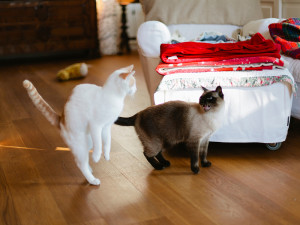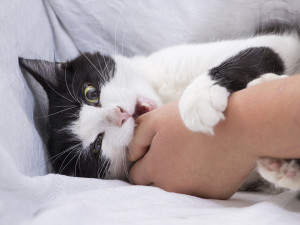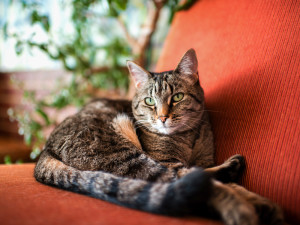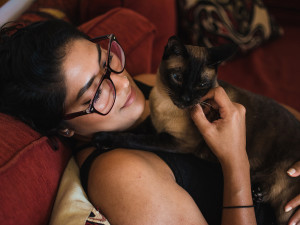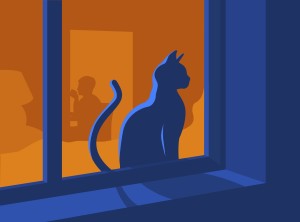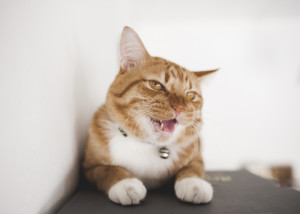Are Your Cats Playing or Is This a Full-On Scar Vs. Simba Fight?
A recent study breaks down the difference.
Have you ever heard a big thump in your living room, run in, and wondered if your two cats are being playful or if they’re going for the full Lion King fight scene? It...can be hard to tell; a lot of what cats do when they play involves behavior that is borrowed from fighting and from predatory behavior. When cats play with toys, most of what they are doing is essentially predatory in nature — but what about when cats play with other cats? It’s easy to spot the serious fights and the gentle bouts of play, but so much of the way cats interact with each other is in that oh-so-vague middle zone.
A January scientific studyopens in new tab explores how to tell if cats are playing or fighting. Researchers studied the interaction between pairs of cats in 105 videos (210 cats) found on YouTube or taken by pet parents. The results offer practical guidelines for determining if cats are playing, fighting, or having an interaction that’s somewhere in between. The research identifies simple cat behaviors anyone can observe to decide with more confidence whether their cats are playing or not.
Save on the litter with color-changing tech that helps you better care for your cat.
In the study, all 105 videos were labeled by four experts — two in academia and two applied animal behaviorists — as either playful, intermediate, or agonistic. (Agonistic is the zoological term for behavior that’s associated with conflict.) Of the 105 videos, seven were removed because the experts didn’t agree about how to categorize those interactions. Each interaction was also analyzed in fine detail based on the specific behavior of each cat.
Then, through a complex statistical analysis, the videos were divided into groups based on what types of behaviors tended to be seen together. The three resulting groups of videos matched up well with the three categories used by the experts to identify the interactions: playful, intermediate, or agonistic. The playful and intermediate interactions had more in common than the intermediate and agonistic interactions.
How much do you spend on your pet per year?
Because cat play and cat fighting are not behaviors that are completely distinct (as are, for example, eating versus running or sleeping versus grooming), and because play is an inherently flexible category of behavior, it’s not possible to set up rules that perfectly sort every interaction into playful or not playful. The fundamental truth about play is this: It’s only play if everyone involved is a willing participant. But that doesn’t make it much easier to tell what’s play and what’s not. This study does offer some guidelines that do exactly that. So, the next time you are watching a couple of cats acting in a way that seems playful, consider the conclusions from the study and how they apply to your cats.
Listen for Chatter
When the interactions between the cats in the study involved conflict, the cats often had bouts of inactivity, and there were lots of vocalizations. They did not have much physical contact, so lots of chasing combined with vocalization is not a good sign. When one cat is always chasing another or always on top in any wrestling bout, the interaction is not reciprocal and is likely agonistic in nature.
Do the Cats Change Positions?
Cats in the study who wrestled without vocalizing were generally being playful, especially when the wrestling lasted a long time. Researchers found that cats are likely playing if they change positions regularly (the same cat was on both the bottom and on the top repeatedly during the interaction). If cats are often in close contact, especially while sleeping, and they regularly share food and toys, the occasional tension in play is not too worrisome. Kittens in the study were especially likely to be playful.
Are the Cats Taking Breaks?
Researchers found that intermediate interactions often had more in common with play than with fighting and tended to involve lots of breaks during which cats reassess the interaction. During what was classified as “intermediate interactions,” cats’ backs were arched, their hair was up, they were hissing, and one cat declined to interact at all. Some intermediate interactions switched between clear play by both cats and situations in which one cat appeared to want to keep playing but the other one didn’t.
Truly intense fights are obvious, but conflict that could lead to trouble is more subtle. Being able to tell if cats are playing or if there is a lot of tension hidden in their interactions can help us keep them happy. Knowledge of what’s play, what’s conflict, and what’s in between makes it easier to know when to interrupt and separate them or when to seek help from a cat behavior expert for the sake of everyone’s quality of life.
Now, let the games begin!


